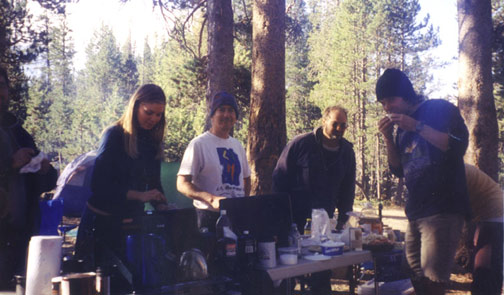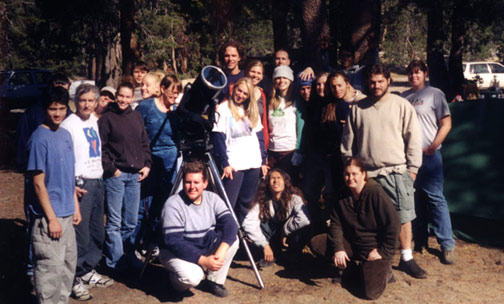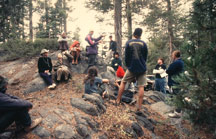Astro 28E: Field Astronomy in the High Sierra - Lunar Grazing
Occultation and the Fall Milky Way
Sept 27-29, 2002
Syllabus
Post-trip highlights
Our course was a great success! We had clear skies both nights and students
got good views of the lunar graze Friday night from camp, thanks to our LIA
Karl's 12" setup. Dave McKulle observed from the other side of the camp
area with his 8" but had some tape recorder problems. I observed from a
mile away and despite cold temperature-induced battery problems and dew, got
a successful video record of multiple events.
 Saturday
morning started with my famous crepe breakfast; crepes made with vanilla soy
and filled with fresh organic fruit, yogurt, and whipped cream. Nothing but
the best for MY students. Here, Courtney carves up some fresh fruit while I
work my magic in the crepe pan. Kevin seems to be enjoying his fruit-and-crepe
breakfast.
Saturday
morning started with my famous crepe breakfast; crepes made with vanilla soy
and filled with fresh organic fruit, yogurt, and whipped cream. Nothing but
the best for MY students. Here, Courtney carves up some fresh fruit while I
work my magic in the crepe pan. Kevin seems to be enjoying his fruit-and-crepe
breakfast.
After breakfast we loaded up and set out for a guided tour of the geology of
the Sierra and comparisons with the geology of the other inner planets. I chose
our first stop at a rare outcropping of metamorphic sedimentary rock amidst
the pervasive granitics of the high Sierra, just above Alpine Lake. Here we
went over the history of the Sierra for the past 120 million years, including
the Cretaceous inland seas, the rise of the volcanic ranges, erosion, sedimentation
in the seas again, and then the rise of the plutons of granite underneath the
extrusive volcanics and their subsequent exposure in the last few million years.
Mountain building happens on Venus as well, but Mercury and Mars do not have
thin enough crusts for plate tectonics to happen today.
Back in the cars we caravaned over Ebbetts Pass, admired the first fall colors
hitting the aspen groves as we approached Monitor Pass and the opening vistas
of the Great Basin. Next stop was Fales
Hot Creek - a stream of perfectly temperature'd hot water cascading
through mini-waterfalls and pools north of Bridgeport. A brief sprinkle from
thunderstorms made climbing into the steaming hot creek a delight, where I continued
our lecture on the inner planet crustal processes, including the formation of
hot springs and the nature of faulting. The Great Basin formed from the stretching
of the earth's crust due to plate tectonics. The stretching caused faulting
and the subsequent intrusion of water down into the hot interior of the earth.
Asymmetric pressure caused mountains to rise and tilt, and for hot springs to
form along these faulting areas. Springs are also now believed to have been
discovered on Mars, although they are not as active as on Earth.
Saturday night included a delicious meal of pasta supplemented with fresh vege
sauces from student contributions. Then we set up the 12" Dobsonian and
studied the star formation regions of the Sagittarius spiral arm of our Milky
Way Galaxy, which rides conveniently in the evening sky of the early autumn.
Lectures on star formation and evolution around the telescope went on well into
the night. Sunday morning started with another awesome crepe breakfast, followed
by for solar study with the 8" Meade.
 Here,
I gathered the troops for sunspot viewing and a lecture on how magnetic fields
inhibit the convective flow of heat from the solar interior and result in cool
spots on the surface. The radiation laws then explain why these cool spots look
so dark. The influence of sunspots on earth climate was described but not explained
because.... we don't KNOW why they influence climate!
Here,
I gathered the troops for sunspot viewing and a lecture on how magnetic fields
inhibit the convective flow of heat from the solar interior and result in cool
spots on the surface. The radiation laws then explain why these cool spots look
so dark. The influence of sunspots on earth climate was described but not explained
because.... we don't KNOW why they influence climate!
Below are some photos I pulled off of slides - the
quick way; I just photographed them with the Dimage 5 by holding the slides
up to a window and using the macro setting.

A rare outcrop of ancient volcanics in the
Sierra - here above Bear Valley. Perfect place for a lecture on mountain
building and the history of the Sierra
|

Fale Hot Creek. Leaning against a soft waterfall
of piping hot water is a great place to listen to a lecture on the volanic
history of the Eastern Sierra
|

Yes - A delightful spot - highlight of the
trip for sure.
|
|
 Saturday
morning started with my famous crepe breakfast; crepes made with vanilla soy
and filled with fresh organic fruit, yogurt, and whipped cream. Nothing but
the best for MY students. Here, Courtney carves up some fresh fruit while I
work my magic in the crepe pan. Kevin seems to be enjoying his fruit-and-crepe
breakfast.
Saturday
morning started with my famous crepe breakfast; crepes made with vanilla soy
and filled with fresh organic fruit, yogurt, and whipped cream. Nothing but
the best for MY students. Here, Courtney carves up some fresh fruit while I
work my magic in the crepe pan. Kevin seems to be enjoying his fruit-and-crepe
breakfast.


